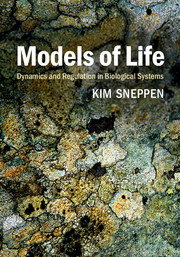Book contents
- Frontmatter
- Contents
- Preface
- 1 Life from a physics perspective
- 2 E. coli as a model system
- 3 Dynamics of regulatory links
- 4 Statistical mechanics of phage λ
- 5 Diffusion and randomness in transcription
- 6 Stochastic genes and persistent decisions
- 7 cis-Acting gene regulation and epigenetics
- 8 Feedback circuits
- 9 Networks
- 10 Signaling and metabolic networks
- 11 Agent-based models of signaling and selection
- 12 Competition and diversity
- 13 Evolution and extinction
- Appendix
- References
- Index
11 - Agent-based models of signaling and selection
Published online by Cambridge University Press: 05 October 2014
- Frontmatter
- Contents
- Preface
- 1 Life from a physics perspective
- 2 E. coli as a model system
- 3 Dynamics of regulatory links
- 4 Statistical mechanics of phage λ
- 5 Diffusion and randomness in transcription
- 6 Stochastic genes and persistent decisions
- 7 cis-Acting gene regulation and epigenetics
- 8 Feedback circuits
- 9 Networks
- 10 Signaling and metabolic networks
- 11 Agent-based models of signaling and selection
- 12 Competition and diversity
- 13 Evolution and extinction
- Appendix
- References
- Index
Summary
Excitable agents as cells in a tissue
Here we introduce agent-based models (ABMs) by demonstrating how they can be applied to to the inflammation propagation model from Chapter 8. The ABM was originally introduced by Von Neumann [567] to deal with system properties of many identical and relatively simple agents that repeatedly use specified rules of mutual engagement [567, 568, 569, 570, 571]. ABMs are accordingly suited for adressing self-organization and emergent phenomena, and have been used to study the properties of living, and in particular, social systems, including segregation [568], traffic jams, evacuation behavior [570], social insect organization [572] and stock-market dynamics, as well as dynamic pattern formation, with ABMs taking the form of cellular automata [567, 569, 573, 574].
Chapter 8 introduced an excitable medium as a model for waves of signaling molecules that facilitate signaling across tissues. Such wave propagation can in fact be rephrased in terms of a simple ABM with agents placed along a line [573, 574, 575]. A cellular automaton is defined in terms of a site variable s(x) that takes a value 0, 1, 2, …σ or takes a value identified as the excited state f. At each timestep all sites x = 1, 2, ….L are updated synchronously:
• For all sites x where s(x) < σ then s(x) → s(x) + 1.
[…]
- Type
- Chapter
- Information
- Models of LifeDynamics and Regulation in Biological Systems, pp. 226 - 241Publisher: Cambridge University PressPrint publication year: 2014



